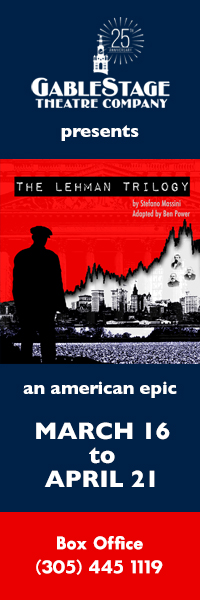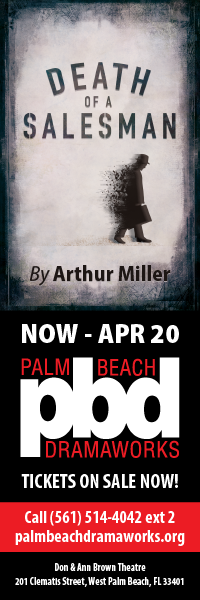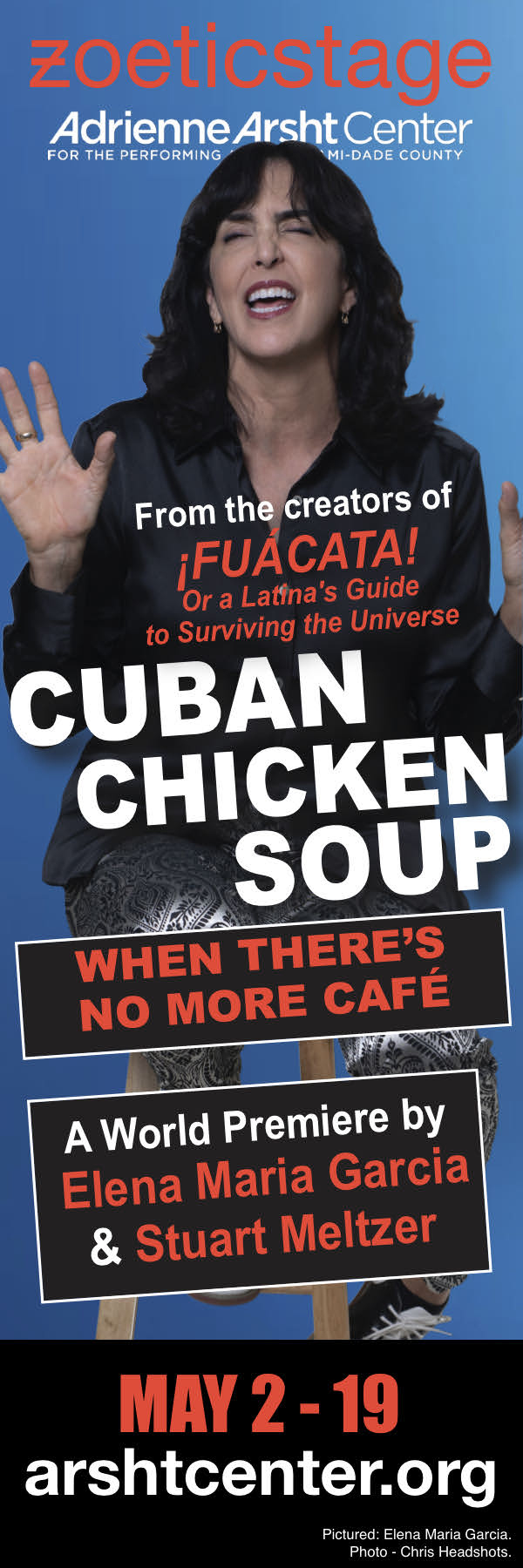By Bill Hirschman
Among a dozen striking images emblematic of the multi-media spectacle H2OMBRE is that of two men dueling 20 feet apart, firing torrents of water from their fingers as if the liquid were magical streams clashing against each other. Think Yoda and Count Dooku.
Later, overgrown lizards scuttle up a wall to battle an unarmed artist. Still later, a gruesome creature noshes on a man caught inside the monster’s mouth. And then sylph-like nymphs morph from sleekly arching beauties into furies manically jogging to a pounding techno beat.
Worldless, disconnected, as neutral and interpretable as a Rorschach ink blot, H2OMBRE is a Cirque du Soleil-like show designed by and aimed at people raised on comic books and fantasy flicks.
Anyone seeking a conventional definition of theater will be appalled at this undertaking partly produced by and hosted at the Arsht Center, much as they were by Fuerza Bruta and The Donkey Show.
But this creation will close in on sheer nirvana for those seeking an immersive experience akin to a South Beach club erected at Comic-Con: aerialists gyrating a few inches above your outstretched hands, inventive projections so consciousness-bending that it will make you dizzy, pounding techno music that rattles the grandstand seats, and to underscore the immersive element, profligate geysers of water soaking those closest to the stage. The production is a smooth amalgamation of surreal impressionistic aesthetic, as well as kids splashing at each other in the neighborhood pool plus a few drug-induced nightmares.
The show is about…. well, it’s about… well, there’s this guy…. And there’s these nasty lizards fellas and these fairies running a marathon and… you know, it’s about … well, it’s…. it’s….
Well, what it’s about is how cutting edge stagecraft can make corporeal damn near anything the imagination can create to produce stunning spectacle in person. In fact, its primary weakness is that the creative team is so deeply in love with their abilities that they don’t know when to pull back: Each of the segments goes on several minutes too long with repetitive riffs, especially for the ephemeral attentiveness of the targeted ADHD crowd.
Bless the creative team’s intent, but all their publicly stated concern about creating a narrative and character development has gone for naught. There is no discernable throughline. Allegedly, it tracks the creative struggle of an artist, but not only is that indecipherable but the artist disappears for most of the second half of the show in favor of some other character, possibly a creation of his mind. Who knows? And for those enjoying it, who cares?
On the other hand, the creators have said that they are not terribly concerned if the audience comes out with a shared interpretation of what they have seen. Instead, individuals are encouraged – indeed, they have no choice but — to impose whatever structure or narrative they wish.
It’s chief influence is comic books, not graphic novels because those have a plot and characters. This has images. For instance, one scene appears to be a giant skull with compartments where the eyes and mouth and brain should be, but they resemble nothing so much as a multi-paneled page in a comic book, as each orifice presents a self-contained scene.
The most compelling proof is the final scene, but to avoid spoiling it — and it is undeniably spectacular – suffice it to say that the images are drawn straight from a score of fantasy novel covers.
Most of the buzz goes to the water sequences although only a couple of the half-dozen sequences are aquatic. But the central soggy section is indeed impressive. It begins with the artist standing on the stage surprised to see water sprouting from is shoulder and trying to staunch it. Then it erupts elsewhere on his body as he haplessly tries to stem the flow. Eventually, it pops out all over him like arterial bleeding. But he experiments playfully with the sprays, liberally spritzing the audience. He is joined by four identically dressed colleagues, each coping with erupting water in different ways. Water bursts out of one’s chest like the creature in Alien, another masters the streams emitted by his hands and creates lovely arcs in the air. Others seem to be lifted in the air by spurts of a fountain. Water goes everywhere, including the dance floor where most of the groundlings in the audience stand for the entire show.
This phantasmagoria was created by Pinchon Baldinu and Gabriella Baldini, the Argentinians responsible for a similar piece of performance art on steroids De La Guarda. Their evolution of this piece since 2008 has been guided for the past year by Scott Shiller, executive vice-president of the Arsht and a proponent of immersive theater.
Some of the movement is courtesy of Broadway choreographer/director Sergio Trujillo (The Addams Family, Jersey Boys) and assistant Veronica Pecollo who have created emotionally-fraught moves reminiscent of Martha Graham and Alvin Ailey.
The performers — actors is probably the wrong word – slide and glide and stretch and grin and grimace on stage as well as twirl at the end of ropes. The protagonist, we think, is played by Leo Kreimer, a tall bald-shaven guy with that demented look that Gov. Rick Scott favors.
But the technical folks are the real stars. They earn awe for their smoothly melded achievements starting with SHANGO Films’ stunning visual projections that create strange worlds viewed from ground level one moment, then switching point of view to directly above the characters. Also on the list are Mariano Toledo’s bizarre costumes, Gonzalo Cordova’s ever-moving lighting whose stabbing arcs are visible thanks to smoke machines, and uncredited sound designers who surprisingly keep the deafening din from being overly oppressive. Credit is also due the local tech crew Jeremy G. Shubrook, Lauren Acker and associate producer Ed Limia.
Gaby Kerpel’s music alternates between that clubby techno beat and ethereal new age meanderings. By the way, while the show is meant to be internationally marketable by being virtually wordless, Kerpel’s lyrics allegedly are Spanish although as with Cirque shows, they could just as easily be Romanian for their unintelligibility.
The Arsht. which is bankrolling this to what we’re guessing tops $2 million, has thrown in everything except the kitchen sink – although it might have been in the adjacent Bubble Bar serving drinks and food under the world’s largest glitter ball repurposed from the Arsht’s last immersive production, The Donkey Show.
The Arsht and its co-producers clearly think its target audience are young people who will tell their friends this is akin to going to a trendy nightspot augmented by a really, really advanced sound and light show.
But if the Arsht really wants to make back its investment, it should tour the comic book convention circuit where word-of-mouth will bring in fanboys by the tens of thousands over and over again in a single weekend.
Caveat to patrons: The performing space and audience area are both on the opera house stage. It essentially is two large areas: one is a dance floor bounded by two elevated stages with audience members standing and dancing in the middle. The other half is a grandstand further away with traditional seating and VIP tables. The latter area will probably stay pretty dry. But if you stand on the dance floor, be prepared to get wet. How wet depends on how close you are to the main stage, but think log flume ride. Patrons are advised to wear shoes and clothes that they don’t mind getting wet or bring a poncho. Purses can be checked at the door. Seriously. We warned you.
H2OMBRE plays through Aug. 31 at the Ziff Ballet Opera House of the Adrienne Arsht Center for the Performing Arts, 1300 Biscayne Blvd., Miami (enter through the loading dock on the north side on 14th Street). 7:30 p.m. Wednesday-Sunday, plus 3:30 p.m. and 10:30 p.m. Saturdays. The show itself lasts an hour, plus a a hakf-hour of pre-show cavorting and a half-hour after-show dance party with music videos hosted by deejays. Tickets are $50, $65, $85 and VIP table packages $125. Call (305) 949-6722 or visit www.arshtcenter.org.
To read our earlier feature on the production, click here.










 A PaperStreet Web Design
A PaperStreet Web Design
